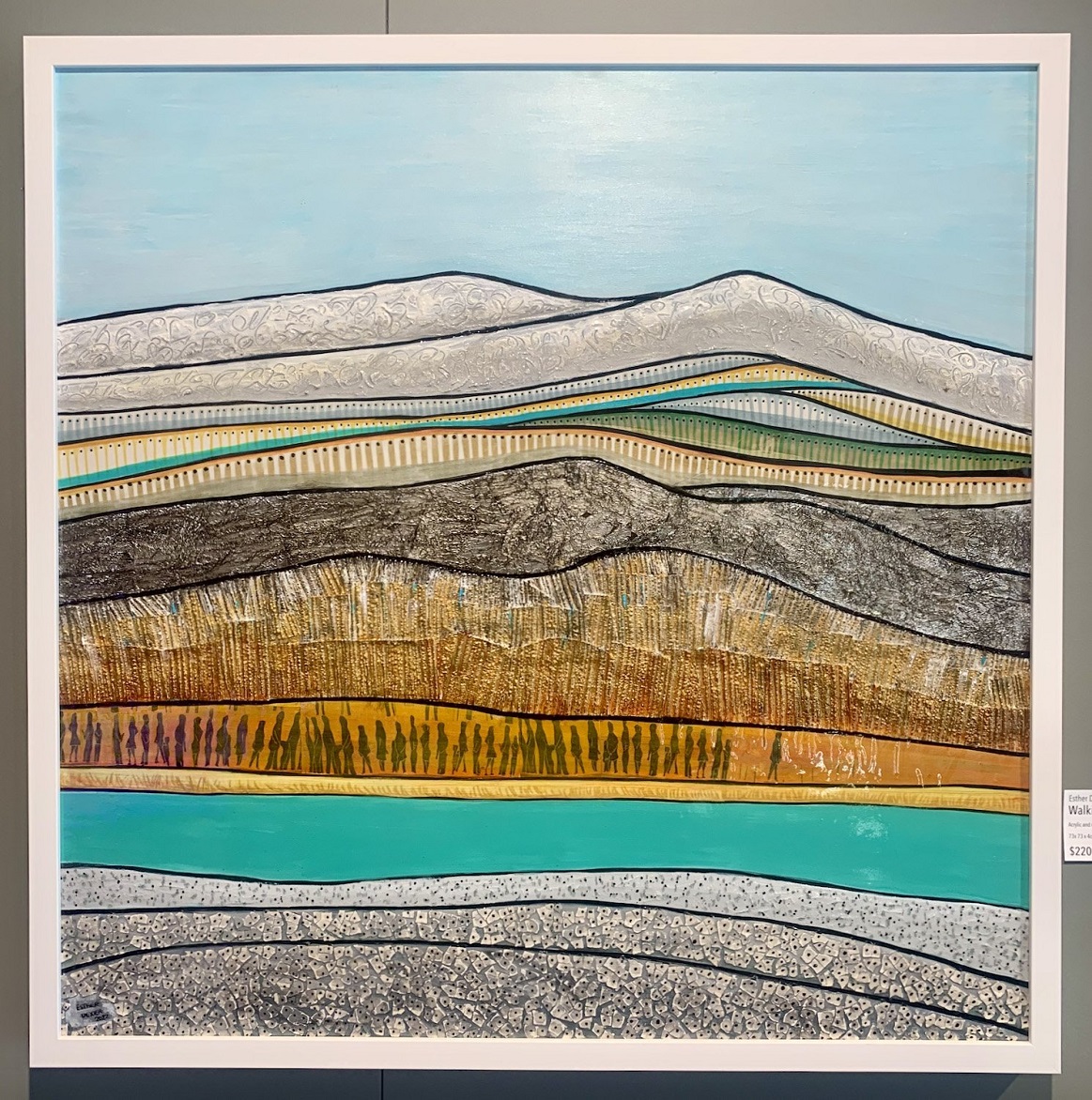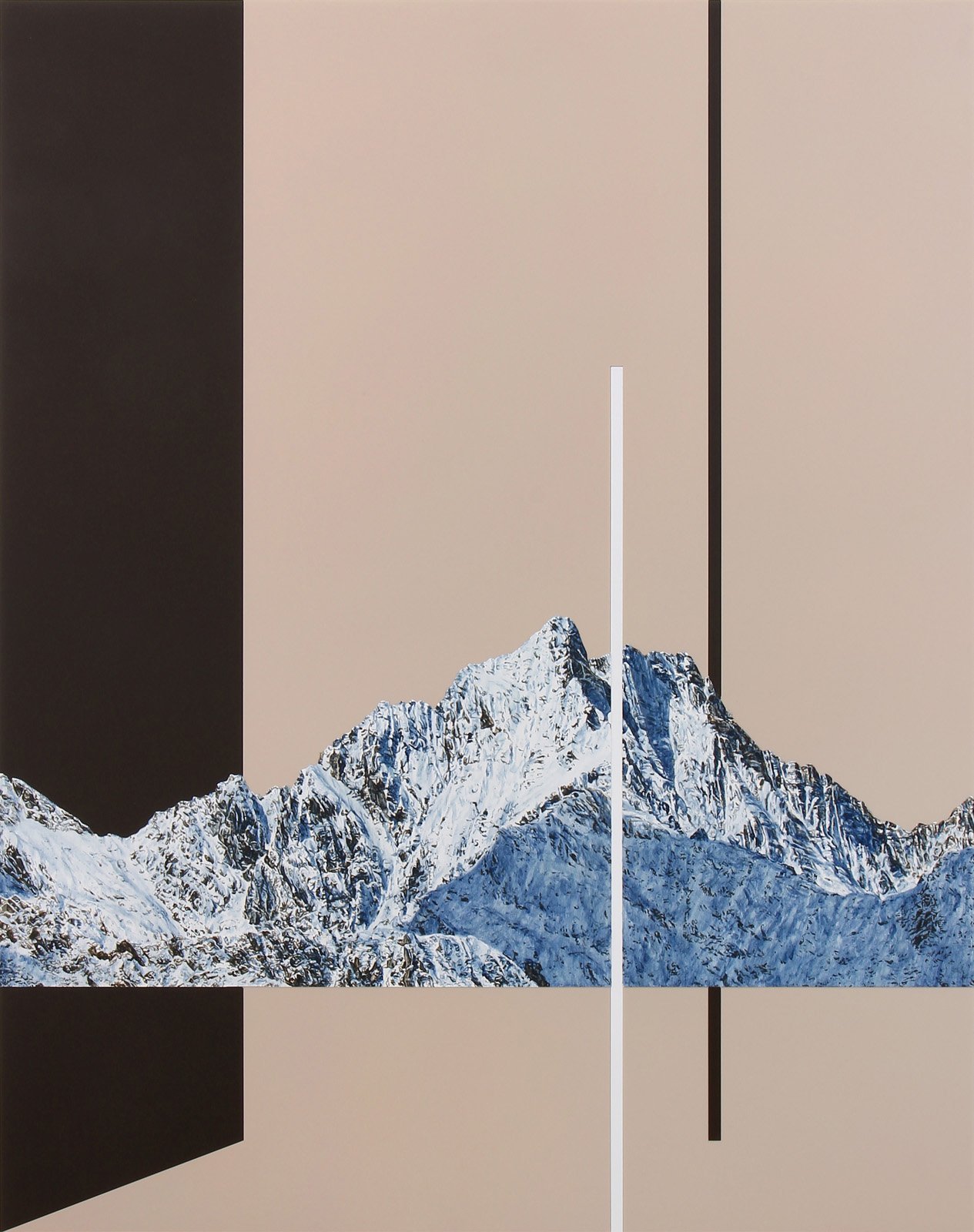
(Eade Gallery, Clyde)
From a distance, trees stretch upwards like flames of red and gold, an iconic sight in autumnal Central Otago — but as you blink, the hint of a face emerges from within the branches, and edging closer, you find another face here and there, a ghostly presence woven into each shape. With beautiful poignancy, Esther Dexter’s Hidden Memories captures the sensations of nostalgia and reflection, the way that specific places and faces are indelibly entwined in our memories. In an adjacent piece, Walking My Own Path, what initially appears to be a line of trees under towering hills solidifies into tiny human figures, as the artist — or viewer — turns their back on all the dissenting voices in their life and heads into the unknown, the light, to find their own way.
Each work in Dexter’s new show "Subliminal" features her characteristic stylised outlines and horizontal bands, but contains hidden messages and affirmations, seemingly endless layers of detail. Words are scattered throughout rolling plains, handwriting etched into rock and tussock like literary footprints. The multimedia collage effect is striking, with crushed foil gleaming like precious metals and iridescent glitter coming alive under the overhead lights. The Mountain of Abundance makes spectacular use of fragmented, hand-painted glass and the judicious use of LED lights, becoming a glowing mosaic. It’s a highly textural, intricately crafted collection — and a very happy one.

(Hullabaloo Art Space, Cromwell)
In one corner of the gallery, an expressive, anthropomorphic hare glowers from the canvas of Lizzie Carruthers’ Dirty Harey, glaring suspiciously at one of his kin, Sue Rutherford’s piquant ceramic Hare. Adding to the sense of whimsy, Andi Regan’s Pixie’s Parasol Fungi hover above like dainty, lacy umbrellas, intricately and ingeniously crafted from interwoven cable ties. The selection of new works at Cromwell’s Hullabaloo Art Space is an appealing mix of the playful and the atmospheric, and each exhibit very much complements another.
Regan’s dyed plastic Welcome Swallows swoop and dive, using the wall as a clear expanse of sky — and one might have kept flying straight into the scene of a neighbouring work, as a lone bird appears amidst the overcast silvery-grey of Ro Bradshaw’s Winter July. The only sign of life in the landscape, is a figure that could be melancholy or simply peaceful, soaring high above the serene, frozen land. That feeling of endless, echoing splendour is echoed in Eric Schusser’s Lone Tree Chatto Creek #1. Schusser’s photography captures not only the sharp visual contrast of light and shadow, and the patterns that emerge within, but the emotions wrought from that quiet stillness.
Robert Franklin’s ceramic pieces are always stunning, edged with smoky grey, artistry burnished across the surface, while Debbie Neill continues to delight with her sculptural figures, bringing the female figure to three-dimensional life with twists and whispers of wire, as if she’s sketched and doodled in the air with metal ink.

(Milford Galleries, Queenstown)
Snowy peaks emerge from drifts of mist and cloud, the foreground and sky blending into one, an alpine dreamscape. In his Shadow Peak and Rock Steps, Neil Frazer harnesses the power of negative space to recreate that unique sensation of being high up in the mountains, where the rest of the world temporarily drops away and you might be the only beings alive, held aloft in a swirl of cloud. The jagged, jutting rock contrasts against the soft background haze with an elemental beauty, echoed in Natchez Hudson’s own high-altitude scenes.
In a deconstructed landscape, Hudson juxtaposes intensely detailed, almost photorealistic mountain ranges with the geometrical blocks and planes of conceptual abstract painting, splicing together the two-dimensional and the illusion of the three-dimensional. Each piece is a reminder of the inherent artificiality of artistic depth and perspective, no matter how realistic a scene might appear, and prompts an exploration into our relationship with the land, both real and painted — what we revere and what we destroy.
Moving further into abstraction and the study of tone, Milan Mrkusich’s Project II Blue makes colour itself the subject, managing to prompt a sensory response just by charting the transition of different shades of blue. Amanda Gruenwald’s work is likewise an investigation and celebration of the physical and emotional properties of colour, one canvas awash with lighthearted joie de vivre, another bleeding into ominous shadow.
By Laura Elliott












